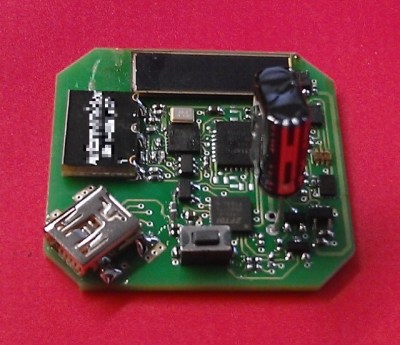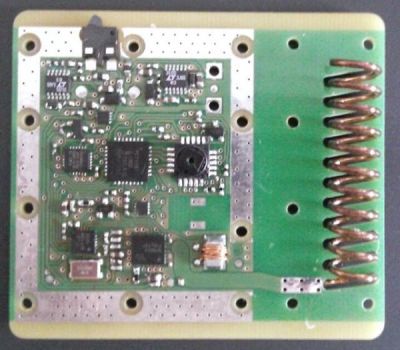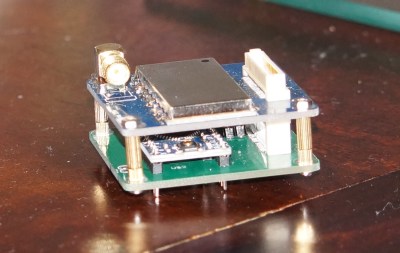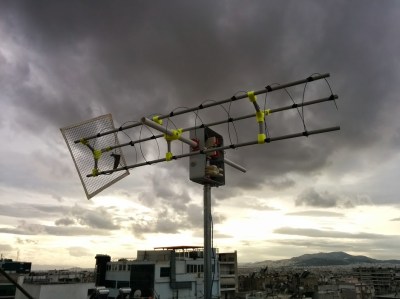Space. The final frontier. Every tinkerer, hacker, and maker has dreamed of flying out of Earth’s atmosphere and into the heavens. Last year one hard-working team got a chance to fly a member to space by winning the Hackaday prize. For the rest of us, we can still experience some of that excitement by contacting satellites in orbit, or even sending a bit of our own hardware into space. This week’s Hacklet focuses on the best satellite projects on Hackaday.io!
 We start with [movax] and Your satellite devkit and launch. Chipsat is a tiny satellite which runs BASIC code. Yes, BASIC in space! Chipsats will be stacked into a launcher and sent off into space in groups. The idea is to eventually have them launched from the International Space Station. Power is provided by a small solar cell which charges up a pair of super capacitors. When the capacitors are charged, the satellite will run for a few seconds. Connectivity with the ground is via a 433 MHz link. Chipsat doesn’t just float in space, three coils give it the ability to control its attitude and rotation. Chipsat will sense the space around it with a magnetometer and a light sensor.
We start with [movax] and Your satellite devkit and launch. Chipsat is a tiny satellite which runs BASIC code. Yes, BASIC in space! Chipsats will be stacked into a launcher and sent off into space in groups. The idea is to eventually have them launched from the International Space Station. Power is provided by a small solar cell which charges up a pair of super capacitors. When the capacitors are charged, the satellite will run for a few seconds. Connectivity with the ground is via a 433 MHz link. Chipsat doesn’t just float in space, three coils give it the ability to control its attitude and rotation. Chipsat will sense the space around it with a magnetometer and a light sensor.
No satellite-themed Hacklet would be complete without [Pierros Papadeas] and his team’s work on SatNOGS – Global Network of Ground Stations. SatNOGS aims to create a global network of connected satellite ground stations. Think of it as a grass-roots version of NASA’s deep space network for satellites in earth orbit. This is more than just a great idea, as SatNOGS won the 2014 Hackaday Prize. You can check out our coverage of the project back in November, 2014. Since then, the SatNOGS team has been busy! They’ve just deployed the first SatNOGS V2 system above their hackerspace in Athens, Greece.
 Next up is TRSI PocketQub Satellite, another project by [movax]. TRSI is a satellite that sends data via images which can be viewed with a simple RTL-SDR stick using Hellschreiber mode. Hell mode means that images can be directly viewed in the waterfall display of whichever SDR application is running the receiver. Numbers or entire images snapped with TRSI’s cell phone style camera module can be encoded and displayed. Power is of course provided by solar cells, and the communications link will be on the coordinated 433 MHz band. The original TRSI hardware has actually morphed into a deployment machine for ChipSat, [morvax’s] other satellite project. He’s put the main TRSI program on hold until after the ChipSat campaign is complete.
Next up is TRSI PocketQub Satellite, another project by [movax]. TRSI is a satellite that sends data via images which can be viewed with a simple RTL-SDR stick using Hellschreiber mode. Hell mode means that images can be directly viewed in the waterfall display of whichever SDR application is running the receiver. Numbers or entire images snapped with TRSI’s cell phone style camera module can be encoded and displayed. Power is of course provided by solar cells, and the communications link will be on the coordinated 433 MHz band. The original TRSI hardware has actually morphed into a deployment machine for ChipSat, [morvax’s] other satellite project. He’s put the main TRSI program on hold until after the ChipSat campaign is complete.
 Rounding out our satellite special is [OzQube] with his project QubeCast Max. QubeCast is the first Australian version of the PocketQube PQ60 satellite form factor. After watching the success of $50Sat project, [OzQube] wanted to design a satellite of his own. Since he wanted to add sensors and send more data back to Earth than previous efforts, he needed a higher data rate than the current crop of satellites. This meant going to a high-powered radio. To achieve this, he’s using a NiceRF RF4463F30 radio module. The module is based upon a Silicon Labs Si4463 RF ISM band chip, coupled with a power amplifier. The module outputs 1 watt, which is quite a bit of power for a tiny satellite!
Rounding out our satellite special is [OzQube] with his project QubeCast Max. QubeCast is the first Australian version of the PocketQube PQ60 satellite form factor. After watching the success of $50Sat project, [OzQube] wanted to design a satellite of his own. Since he wanted to add sensors and send more data back to Earth than previous efforts, he needed a higher data rate than the current crop of satellites. This meant going to a high-powered radio. To achieve this, he’s using a NiceRF RF4463F30 radio module. The module is based upon a Silicon Labs Si4463 RF ISM band chip, coupled with a power amplifier. The module outputs 1 watt, which is quite a bit of power for a tiny satellite!
Want more satellite goodness? Check out Hackaday.io’s freshly minted Satellite List.
The countdown is almost at 0, so that’s just about all the time we have for this episode of the Hacklet. See you next week. Same hack time, same hack channel, bringing you the best of Hackaday.io!

















Chipsat doesn’t just float in space, three coils give it the ability to control its attitude and rotation. Chipsets with a attitude are amazing, i tell you!
Well spoken, sir!
That is pretty dang awesome. But in a practical sense, is there really a need for dynamic attitude control on such a basic satellite, rather than just using a permanent magnet?
Is anyone trying for that Google prize to land a device on the moon? Would any of the above be able to communicate that far?
Communication so far is not that big problem.
In my opinion, most of the groups focused on the “rover”, only a few think about the lander.
Some groups are open, so everyone can join – the question is: Who really has the capabilities to LAND on the moon?
You can be brought into orbit for 300000$ for a 1kg payload (Cubesat form factor). Put some hydrazine/nitrous tetroxide inside with some valves – and you got a lander – note the irony. A rover is not the hard part – really not
Have any of these actually been tested in space?
The Kicksat project was the first one to try. Unfortunately the deployment failed, so the chipsats burned up :(
I got some experience in Picosatellites (sent one up actually) – now I try to make the launch accessible to even more people (cause the costs are still quite high)
Are Supercaps really specs for LEO!? AFAIK they use water (or water based) electrolyte and their rather limited operating range is -25C to 70C. Not to mention the freezing and thawing cycles might not be too kind to it. Thankfully when there is sun light, it won’t be freezing. Wouldn’t one of those “solid state” caps with a dry dielectric be more suitable?
BTW Space station is in LEO not really “Space”.
Within the 6 weeks of operation this should be ok.
With proper thermal control system (the easy way is to transfer the heat to the other side of the PCB, the cold side) the temperatures of the parts stay within the specifications in the datasheet, -15 to +60
Officially, everything above 80km is space.
The ISS orbits in 400km – it´s definitely a space station.
Operating range temperatures will not be exceeded by proper temperature control. You must take care of transferring the heat from one side of the PCB to the other. What helps is to put off the dark coating of the caps so they reflect the sunlight – and thermaly bound them to the ground layer on the other side. This prevents them from freezing and overheating even if the sat maintains a steady attitude. If it´s in “barbecue mode” – rotating – then it´s no problem at all. The mean temeperature will be around +10°C
I think the main problem wouldn’t be the caps freezing and thawing so much as them exploding. Being a strong vacuum the only real heat transfer in space is due to radiation, hence the need to avoid dark patches or cover them with something shiny. Of course liquids also boil under a strong enough vacuum, so the capacitor casing must be strong enough to maintain some pressure.
They are encapsulated well. I have tested several ones in vacuum – heated them up to 80°, no problem.
Of course I´ll check the caps too in worst case conditions before they fly up.
I understand the 70cm band is “easier” to use, but perhaps Amateur radio and amateur satellite communities should consider using the shorter wave length allocations for satellites, so they aren’t characterized as unused by the for profit(and non-profit) entities that would covet them.